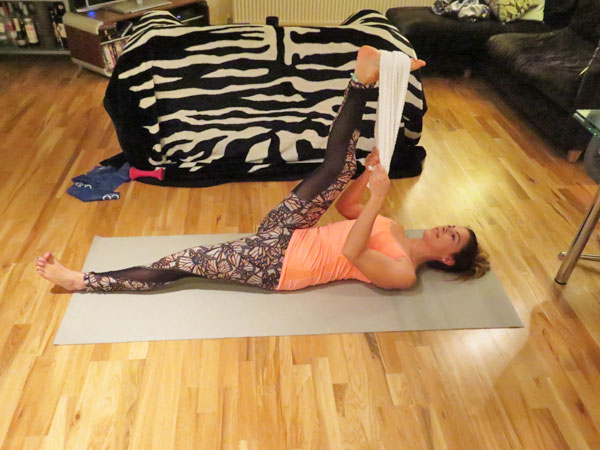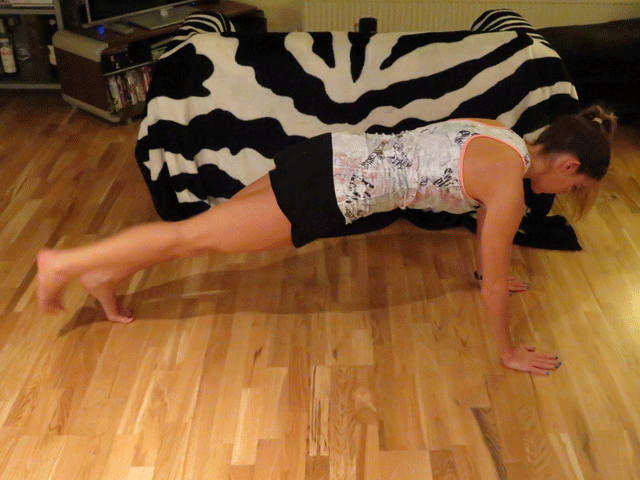Bad backs have become one of the most common plights of office workers, and the symptoms are hitting us earlier and earlier. My husband is just 32 and he regularly sees a physio to contend with painful pressure on his sacral spine caused by long hours at his desk. A colleague of mine at Sweaty Betty (repeatedly recognised as having the UK’s healthiest employees) has also raised concerns about back pain and poor posture, so she asked me to train with her once a week to help rebalance her upper body.
I’m personally thrilled that spine health has become the topic du jour because, aside from my appreciation of a well-sculpted back, I’ve always prioritised the posterior in my own workout programmes to prevent spinal misalignment and better support my body through all other exercises and activities. These three exercises are a great addition to your floor work and ideal for gradually building up your strength by choosing the best adaptation for you.
Extended plank with front raise and row
Take an extended plank position with your feet in a wide stance and a dumbbell to your side. Make sure you feel secure in that posture, with your hips parallel to the floor and your belly button glued into your spine. Now hold the dumbbell in one hand and slowly raise it to shoulder height in front of you, then row it up to your obliques with your elbow pointing directly to the ceiling. No wriggling hips! Repeat all your reps on one side (I suggest 8-12), then switch over.
Adaptation: If you start to dip through your lower back or feel overly tempted to raise your butt to the ceiling, drop to your knees, tuck your pelvis and engage your core to maintain a single straight line from your ankles to your head. You can also perform this movement without weight – the element of instability can be enough to improve the muscular balance around your spine.
Resistance band back raise
Lie flat on your stomach with your arms extended above your head, holding a resistance band with just enough tension to engage the muscles around your shoulder blades. Now breathe in as you slowly curl your head and shoulders off the mat, then breathe out to row the resistance band in towards your chest. Try to keep steady tension in the band throughout. Extend your arms as you inhale and lower down on the exhale. Do 10-12 reps.
Adaptation: If you feel too much pressure on your lower back, lose the resistance band and try it without using added resistance. Or take your hands beside your ears and simply lift and lower your shoulders off the floor, removing the row from the exercise.
Windshield wipers
Turn over to your back and take your legs to a table top or extended 45 degree position, keeping your lower back glued to the floor and your core switched on. Maintain this ‘corset’ feeling as you slowly lower your legs towards the floor on your right side, keeping your left shoulder in contact with the floor. Now slowly return to the centre and repeat to the left. Repeat this slow ‘tick tock’ motion 8-12 times.
Adaptation: Keep your knees bent in tabletop position to reduce the pressure on your lower back as you twist from side to side. Only go as far as feels comfortable for you – reduce the range of motion if you begin to feel as though you need momentum to get back to the central position.
Plus, the non-negotiable stretch…
You may not think that stretching your hamstrings has any impact on your back, but tightness through the thighs is one of the most common reasons for lower back pain. When your hamstrings are tight, they pull down on your pelvis and the strain has a domino effect up the spine. Prolonged tightness can eventually compress the discs in the lumbar and sacral spine – pair that with hours at your desk and you risk developing unsightly hunchback tendencies. Take your pick: Clark Kent or Quasimodo? Queen Grimhilde (Snow White’s wicked witch) or Mulan?
The key to an effective hamstring stretch is holding it long enough. Set your time on your iPhone to 60 seconds – and don’t stop short! I like to wrap a towel around my foot to gradually increase the stretch, extending the leg straight with each in breath and relaxing it further towards the forehead with each out breath. Switch legs. Now get up, and stand tall.
Are there any other niggling weaknesses you’d like to address? Let me know in a comment below so I can plan a post to support your training!





